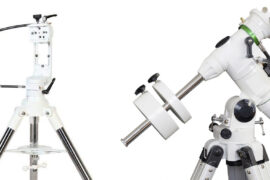The refracting telescope was invented over four centuries ago.
While the design has been perfected over the years, the general concepts have remained the same. More sophisticated types of telescopes have been created since, and yet, the refractor is still the most popular amongst hobbyists.
If you are in the market for a telescope, it is important to learn the pros and cons of refracting telescopes so you can make an informed decision as to whether or not one is a good fit for your needs.
In this article, we’ll analyze the advantages and disadvantages of refracting telescopes and learn a bit more about their design.
But first.
What is a refracting telescope?

Refracting telescopes – also known as refractors – are the most popular type of telescope. They use lenses at the front to refract the light which converges into a single point at the opposite end of the tube. The light is then focused by the eyepiece where the user sees the resulting image.
The design of refracting telescopes is simple, elegant, and functional. It is for those reasons it transcended astronomy and is also used in other industries such as photography.
When someone says the word ‘telescope’, a refractor is most likely the image that you see in your head.
The design was popularized in the 17th century by big-name astronomers you have probably heard of such as Galileo Galilei and Johannes Kepler.
Types of refracting telescopes
There are two main types of refracting telescopes. Achromatic and apochromatic. It is important to know the distinction because at some point you might see two refractor telescopes with the same aperture, focal length, and equal specifications, but one is hundreds of dollars more expensive than the other. This could be because one is achromatic and the other is apochromatic.
Achromatic refractors use the same simple design that has been used for centuries. It uses a single lens and is extremely functional, but as you will learn in the sections below, it has some limitations when it comes to colors.
Apochromatic refractors are a more recent and sophisticated design. They use the same basic concepts, but use two or three-element lenses to correct the chromatic and spherical errors that achromatics sometimes show.
Advantages (pros) of refracting telescopes

These are the advantages refracting telescopes have over other types of devices.
- The tube in refractors is completely sealed. This protects the lens from dust and humidity, eliminating the need for regular internal cleanup.
- Refractors are very low maintenance as they do not require regular collimation (re-aligning the lenses). This makes them extremely beginner friendly.
- They are lightweight and relatively small, making them portable and easy to store.
- Refractors have better heat dispersion than Newtonians. This means they don’t need as much cooldown time before using them.
- They perform great when observing very bright objects, like the Moon during one of its fuller phases.
- Because they use lenses instead of mirrors, the optics in refractors are crisp, sharp, and high-contrast images.
Apochromatic telescope advantages
The following applies only to apochromatic telescopes (APO for short).
- The short focal length and focal ratio makes them ideal to observe deep space objects (such as galaxies, nebulas, etc).
- They are generally “fast” telescopes (short light transmission time between the front lens and the exit pupil). This makes them the superior choice for astrophotography, even if they have a smaller aperture.
- The double or triple-element lens design fixes most of the color errors that can appear in achromatic devices.
Disadvantages (cons) of refracting telescopes
On the other hand, here are the downsides of refractors.
- The lenses used in refractors are very hard to manufacture in large sizes. As a result, they are only available in apertures under 130mm.
- Because of the above, the larger refractors (above 90mm) are also significantly more expensive compared to Newtonians of the same aperture.
- Refracting telescopes have some issues with chromatic errors. This means they sometimes show colors incorrectly or show a “ring” around some objects. This is less of a problem with apochromatic scopes.
- Because of their smaller aperture, refractors have a low magnification. This limits the level of detail you can get when observing certain objects, specifically planets or the Moon.
- Some lower-quality refractors also suffer from spherical aberration, an optical defect where the light does not get refracted to a single point, causing a “sphere” effect around the edges of the image.
Summary
- Refracting telescopes are very popular amongst stargazers due to their many advantages.
- Some of the pros of refracting telescopes are low maintenance, portability, and sharp, bright images.
- Some of the cons of refracting telescopes are their limited size, chromatic errors, and pricing when compared to designs that use mirrors instead of lenses.
Enjoyed this article?
Get daily 10-minute PDFs about astronomy to read before bed!
Sign up for our upcoming micro-learning service where you will learn something new about space and beyond every day while winding down.







